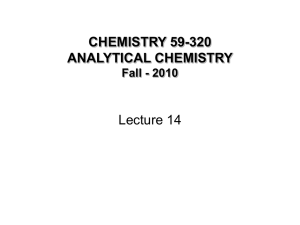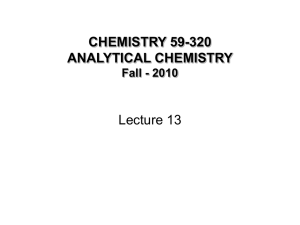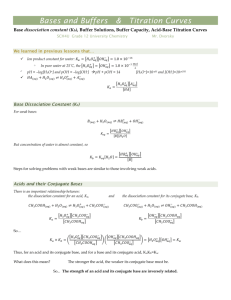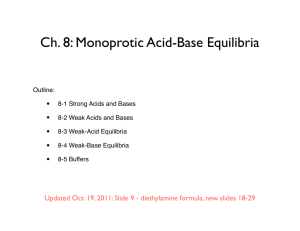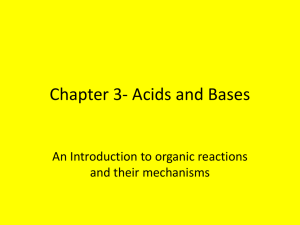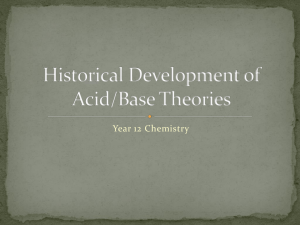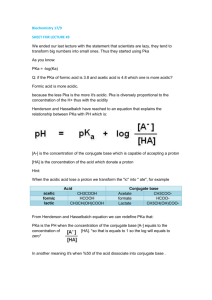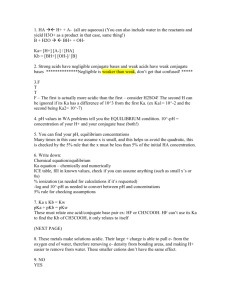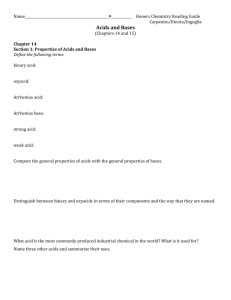1. Review of Acid
advertisement
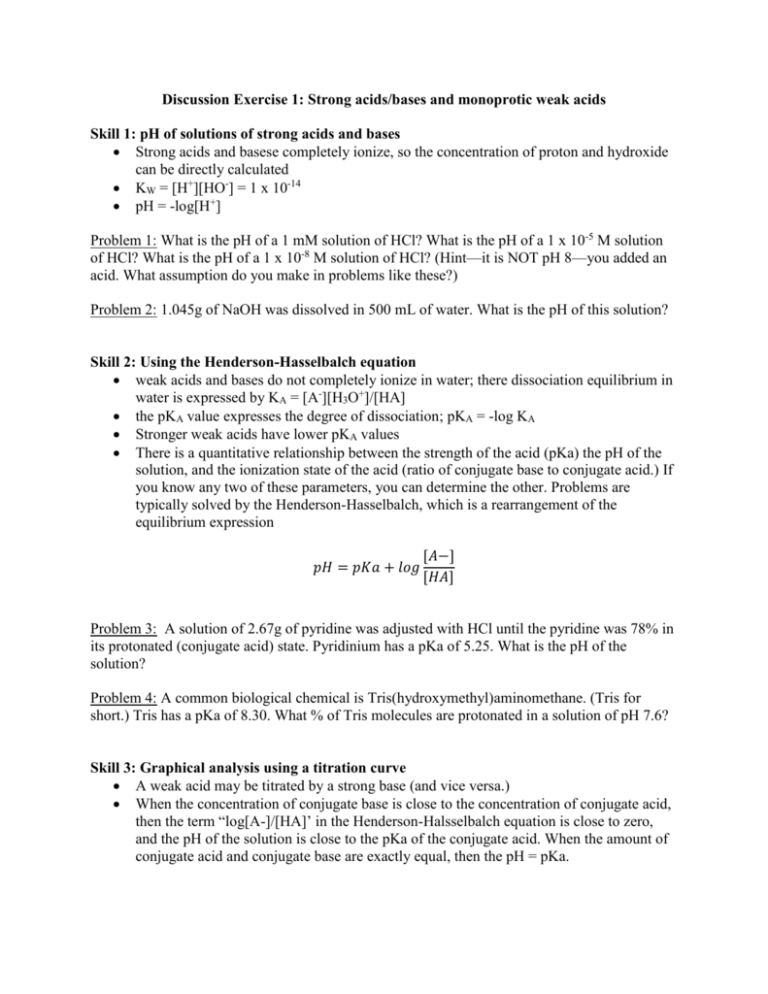
Discussion Exercise 1: Strong acids/bases and monoprotic weak acids Skill 1: pH of solutions of strong acids and bases Strong acids and basese completely ionize, so the concentration of proton and hydroxide can be directly calculated KW = [H+][HO-] = 1 x 10-14 pH = -log[H+] Problem 1: What is the pH of a 1 mM solution of HCl? What is the pH of a 1 x 10-5 M solution of HCl? What is the pH of a 1 x 10-8 M solution of HCl? (Hint—it is NOT pH 8—you added an acid. What assumption do you make in problems like these?) Problem 2: 1.045g of NaOH was dissolved in 500 mL of water. What is the pH of this solution? Skill 2: Using the Henderson-Hasselbalch equation weak acids and bases do not completely ionize in water; there dissociation equilibrium in water is expressed by KA = [A-][H3O+]/[HA] the pKA value expresses the degree of dissociation; pKA = -log KA Stronger weak acids have lower pKA values There is a quantitative relationship between the strength of the acid (pKa) the pH of the solution, and the ionization state of the acid (ratio of conjugate base to conjugate acid.) If you know any two of these parameters, you can determine the other. Problems are typically solved by the Henderson-Hasselbalch, which is a rearrangement of the equilibrium expression 𝑝𝐻 = 𝑝𝐾𝑎 + 𝑙𝑜𝑔 [𝐴−] [𝐻𝐴] Problem 3: A solution of 2.67g of pyridine was adjusted with HCl until the pyridine was 78% in its protonated (conjugate acid) state. Pyridinium has a pKa of 5.25. What is the pH of the solution? Problem 4: A common biological chemical is Tris(hydroxymethyl)aminomethane. (Tris for short.) Tris has a pKa of 8.30. What % of Tris molecules are protonated in a solution of pH 7.6? Skill 3: Graphical analysis using a titration curve A weak acid may be titrated by a strong base (and vice versa.) When the concentration of conjugate base is close to the concentration of conjugate acid, then the term “log[A-]/[HA]’ in the Henderson-Halsselbalch equation is close to zero, and the pH of the solution is close to the pKa of the conjugate acid. When the amount of conjugate acid and conjugate base are exactly equal, then the pH = pKa. A titration curve looks like the following graph. This is a titration of acetic acid, with a pKa of 4.7. The endpoint is reached when the amount of base added is equal to the amount of acetic acid present in the solution. Problem 5. If a solution with 80.0 mmol of acetic acid is treated with 20 mmol of NaOH, where is this point on the titration graph above? Based on the graph, what is the pH of this solution? Now solve this using the Henderson-Hasselbalch equation. Did you get the same pH value? Problem 6. Draw a titration curve like the one above for Tris. (See problem 4.) Skill 4. Buffers Buffers are solutions that resist a change in pH when strong acids or strong bases are added. Buffers are able to do this because there is a significant amount of a weak acid present in both its conjugate acid and conjugate base form. These weak acids/bases react with the strong acids/bases to “soak them up” so that they don’t change the pH of the solution much. Buffers are only effective when they are ± 1.0 pH units away from the pKa of the buffer. Problem 7. An acetic acid/acetate buffer would only be effective on the range of 3.7 to 5.7. Explain. Problem 8. What is the ratio of conjugate acid to conjugate base in an acetic acid/acetate buffer at pH 3.7? What is the ratio of conjugate acid to conjugate base in an acetic acid/acetate buffer at pH 5.7? Use the Henderson-Hasselbalch equation to solve for these values. Problem 9. Draw a titration curve for the acetic acid/acetate buffer, and mark the region in which the buffer is effective. Problem 10. One liter of a 1.0 M Tris buffer (pH 8.0) is treated with 1 mL of 10 M NaOH. What is the pH of this solution? Problem 11. One liter of pure water (pH 7) is treated with 1 mL of 10 M NaOH. What is the pH of this solution? Compare this to the buffered solution and comment.


